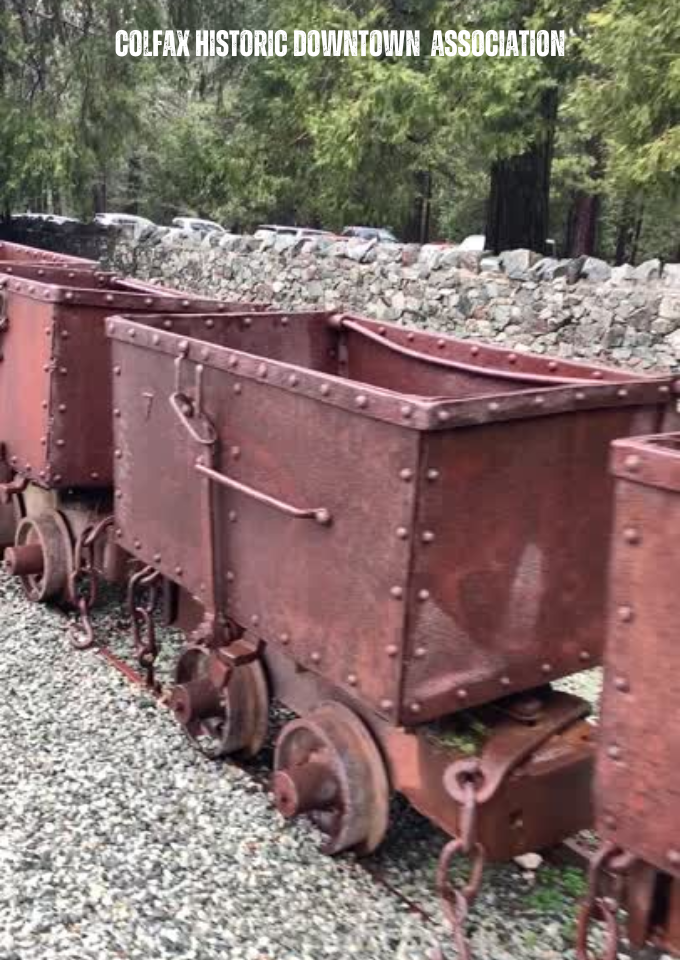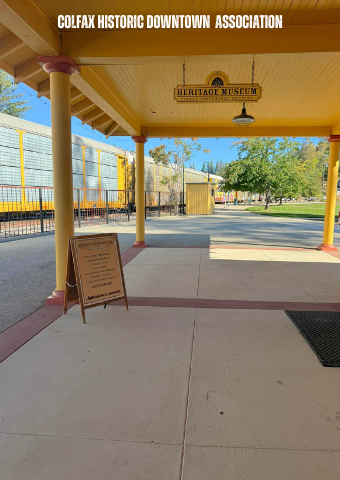Historic Colfax, CA: A Hub of Gold Rush and Railroad Legacy

Tucked in the foothills of the Sierra Nevada, historic Colfax, California, stands as a living testament to the intertwined histories of the Gold Rush and the rise of the American railroad. This small town, founded in the mid-19th century, played a critical role in the transportation of goods, services, and people, both during the peak of California’s gold rush and the expansion of the transcontinental railway system. Leveraging its strategic location, Colfax became a pivotal hub, bridging the industrial heart of the country with the gold-laden hills of the West.
Colfax: A Gold Rush Town

Like many towns in the Sierra Nevada, Colfax was shaped by the discovery of gold in California in 1848. The rush of miners seeking fortune spread quickly across the region, leading to the development of various mining towns. Colfax, originally known as “Illinoistown,” was one of these rapidly expanding settlements, growing from a camp for gold miners into a full-fledged town as news of the precious metal spread.
What distinguished Colfax from other mining towns, however, was its strategic importance. While mining operations flourished in nearby areas like Grass Valley and the Empire Mine, Colfax quickly became known as a vital supply center for miners. As miners swarmed into the nearby hills, the demand for provisions, tools, and services grew, and Colfax met these needs by serving as a gateway to these mining regions. The town’s economy was driven by merchants and suppliers who provided goods and equipment to miners venturing deeper into the Sierra Nevada.
Even as nearby gold mines dwindled and others failed, Colfax remained relevant, adapting to changing times. Its initial reliance on gold was supplanted by its greater role in regional trade and commerce. Its location on the edge of the mining districts and along key travel routes made it a natural hub for supplying the miners working in the Sierra Nevada. The town served as the last stop before many miners pushed onward toward gold fields.
The Rise of the Railroad in Colfax
The history of Colfax is perhaps most prominently linked with the railroad. As the Gold Rush brought people west, the need for more efficient travel and transportation was urgent. The construction of the Transcontinental Railroad answered this call, and Colfax played an integral role in its development. The town is forever tied to the legacy of the Central Pacific Railroad, one of the two companies responsible for building the Transcontinental Railroad.

In 1865, Colfax was named in honor of Schuyler Colfax, Speaker of the House of Representatives and later Vice President under Ulysses S. Grant. Colfax visited the town during a tour of the West, aimed at understanding the importance of the railroad to the growing nation. His name became synonymous with the town and its emerging significance as a railroad center.
The completion of the Transcontinental Railroad in 1869 marked a turning point not only for Colfax but for the nation. The railroad transformed the town from a simple mining supply stop to a bustling railroad hub. Colfax was situated on the primary line connecting Sacramento to the East, and trains carrying supplies, passengers, and mail made regular stops here. This role as a transportation hub cemented Colfax’s importance in California’s development and ensured its survival long after other mining towns had faded away.
The impact of the railroad cannot be overstated. It connected Colfax to major cities across the country, creating economic opportunities and ensuring that the town remained relevant as a commercial center long after the Gold Rush had ended. Railroads opened up the West to further development, allowing towns like Colfax to grow and thrive even as gold mining diminished. Today, the town’s connection to the railroad can still be seen, both in the functioning tracks and the historic markers that dot its streets.
Colfax and the Empire Mine
Colfax’s role in supporting the Empire Mine, one of the richest and longest-operating gold mines in California, is another crucial element of its history. Located in Grass Valley, just a short distance from Colfax, the Empire Mine produced over 5.8 million ounces of gold between its discovery in 1850 and its closure in 1956. Colfax served as a key logistical hub for the mine, facilitating the movement of supplies and workers.
The Empire Mine relied heavily on the efficient transport systems that towns like Colfax provided. As the mine grew in scale and output, the need for transportation to and from the site became more pressing. Colfax, with its railroad connections and established commerce, was a lifeline. Rail cars carried the necessary materials—timber, equipment, and food—up to the mines, and just as importantly, shipped out the gold extracted from the earth.
The relationship between Colfax and the Empire Mine also underscores how integral transportation networks were to the success of the Gold Rush. Without towns like Colfax and the infrastructure they supported, mines like the Empire might not have reached the levels of success they did.
The Nevada County Narrow Gauge Railroad
One of the most fascinating pieces of railroad history in Colfax is its connection to the Nevada County Narrow Gauge Railroad. Built between 1874 and 1876, this 22-mile-long railroad connected Colfax to Grass Valley and Nevada City, serving both passenger and freight needs. The line became particularly important for transporting goods from the larger Central Pacific Railroad in Colfax to the more remote mining towns.
A distinctive feature of this railroad was its management by Sarah Kidder, who became the world’s first female railroad president after her husband, John Flint Kidder, passed away in 1901. Under her leadership, the railroad thrived for more than a decade, cementing its place in local history.
Though the rails were eventually taken up in 1942, the legacy of the Nevada County Narrow Gauge Railroad remains an important part of Colfax’s story. The railway helped sustain the town’s importance even after the decline of the gold mining industry, connecting it to other economic centers in Northern California.
The Role of Cape Horn in Railroad History
Cape Horn, a section of the transcontinental railroad located just outside Colfax, is one of the most dramatic examples of early railroad engineering. Constructed in the 1860s, the track winds its way around steep cliffs, providing breathtaking views of the American River Canyon below. It was a daunting challenge for the railroad builders, many of whom were Chinese laborers working under incredibly dangerous conditions. The construction of Cape Horn required workers to be suspended from the cliffs in baskets to carve out the path for the railroad.
This engineering marvel became an iconic part of the railroad’s journey through the Sierra Nevada and remains a symbol of the sheer determination required to connect the West to the rest of the country. Today, visitors to Colfax can drive a short distance to see the Cape Horn lookout, where the tracks still wind along the cliffs, a reminder of the area’s rich railroad history.
Preserving the Legacy: Historical Markers in Colfax
Colfax has taken great strides to preserve its history, particularly through its many historical markers. Visitors can take a walking tour of the town’s key historical sites, many of which date back to the Gold Rush and early railroad days. Highlights include the original Colfax Passenger Depot, which now serves as a visitor center and museum, as well as the first transcontinental railroad marker, which commemorates the arrival of the first train in Colfax in 1865.
Other notable sites include the IOOF Hall, Masons Lodge, and several historic saloons and trading posts that were established in the 1860s and 1870s. These buildings, many of which still stand today, offer a glimpse into the daily life of a bustling 19th-century town. Visitors can also explore the Schuyler Colfax statue, a tribute to the man who gave the town its name and played a pivotal role in the development of the American West. Check out the Walking tour Map by the City of Colfax.
Colfax Today: A Town Steeped in History
While much of Colfax’s story is rooted in its past, the town continues to thrive today as a charming community that celebrates its rich history. The town’s historical society and local government have worked diligently to preserve its heritage, offering visitors a chance to step back in time and experience the Gold Rush and railroad eras firsthand.
Tourists flock to Colfax not only for its history but also for its proximity to outdoor recreation in the Sierra Nevada. Whether hiking along the old railroad routes, visiting nearby mines, or simply enjoying the historic downtown, visitors to Colfax can immerse themselves in a unique blend of nature and history.
FAQs
What role did Colfax play during the Gold Rush?
Colfax served as a key supply center for miners heading into the Sierra Nevada during the Gold Rush. The town provided goods, services, and equipment necessary for mining operations.
How did the railroad impact Colfax?
The construction of the Transcontinental Railroad in the 1860s transformed Colfax into a crucial railroad hub, connecting it to major cities and ensuring its continued relevance in trade and transportation.
What is the significance of Cape Horn near Colfax?
Cape Horn is a section of the transcontinental railroad built in the 1860s. Its construction around steep cliffs was a major engineering feat and remains a symbol of the challenges faced by railroad workers.
What was the Nevada County Narrow Gauge Railroad?
The Nevada County Narrow Gauge Railroad was a 22-mile railroad that connected Colfax to Grass Valley and Nevada City, playing a critical role in transporting goods and passengers between these towns.
Who was Schuyler Colfax?
Schuyler Colfax was the Speaker of the House and later Vice President of the United States. The town of Colfax was named in his honor after he visited the area during a tour of the West.
How has Colfax preserved its history?
Colfax has preserved its history through various historical markers, a walking tour of key sites, and the preservation of its original railroad depot, now a museum and visitor center.
Conclusion
Colfax, California, stands as a symbol of the American West, where the Gold Rush and the railroad converged to shape the future of the nation. From its beginnings as a mining supply town to its role as a railroad hub, Colfax’s history is rich with stories of determination, innovation, and survival. Today, the town offers visitors a unique opportunity to explore this history, from the tracks of the transcontinental railroad to the hills where miners once searched for gold. As Colfax continues to preserve its past, it remains a testament to the spirit of the West.
Find out how you can help us preserve our Gold rush and railroad history in the Colfax Area! Learn more about the Historic Colfax Downtown Association
